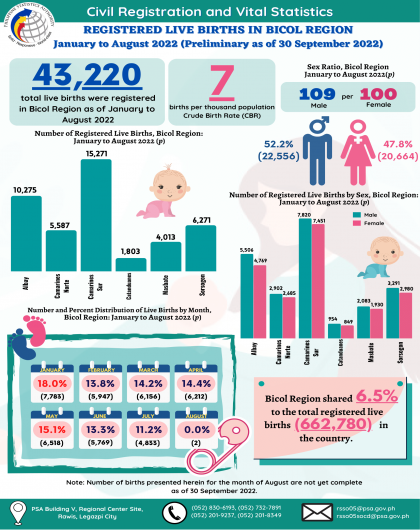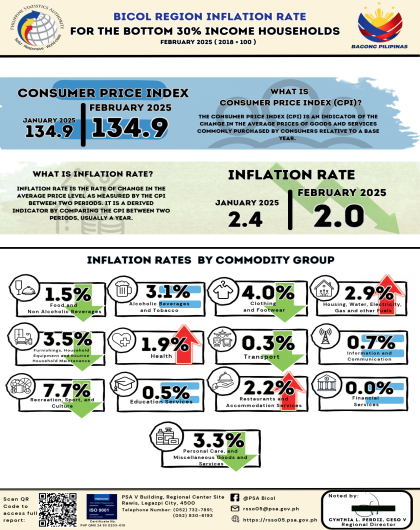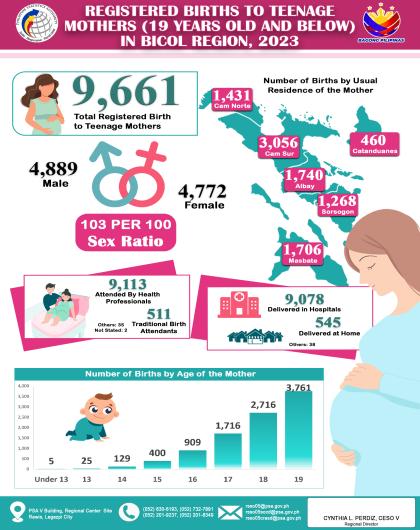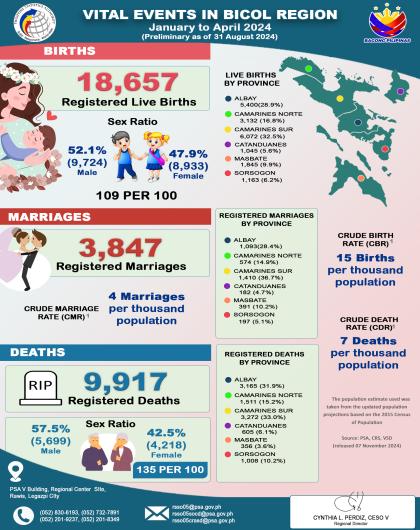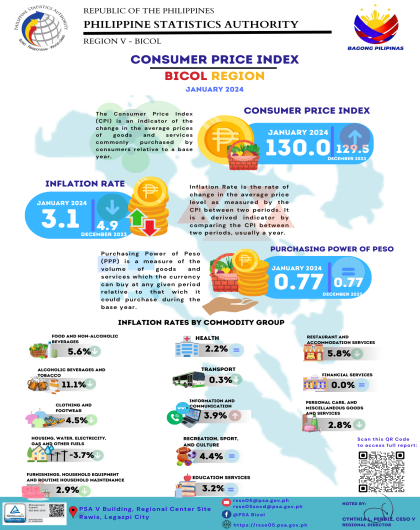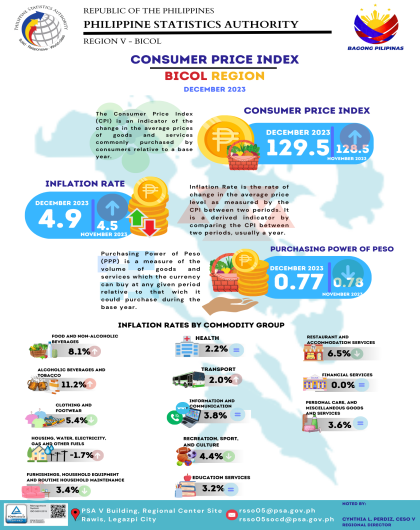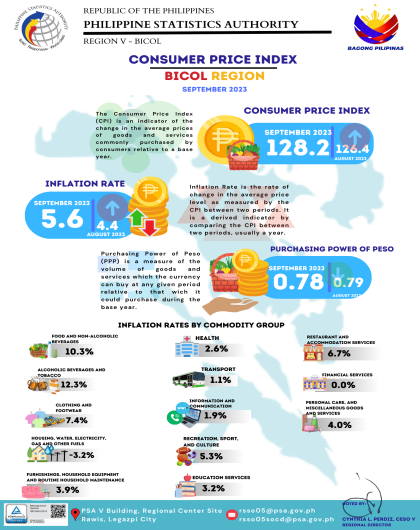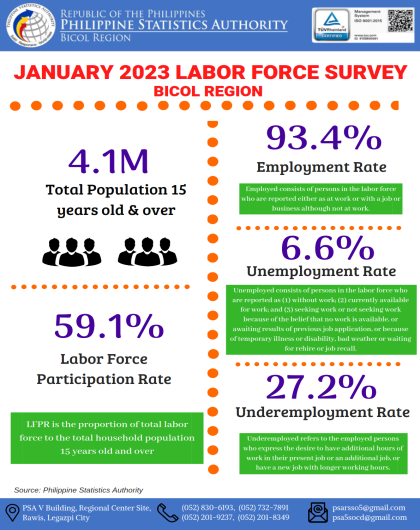Seven births per thousand population
In January to August 2022, a total of 43,220 live births were registered in Bicol Region. This figure is about 6.5% share to the total registered live births (662,780) in the country. For this period, Bicol Region registered a crude birth rate (CBR) of 6.9 or 7 births per thousand population.
The number of registered live births decreased by 20.1% or 10,854 live births in January to August 2022 from 54,074 registered births in the same period of 2021.
Camarines Sur had the most number of registered births among provinces in January to August 2022 with 15,271 or about 35.3% registered births. It was followed by Albay with 10,275 or 23.8% registered births, and the province of Sorsogon with 6,271 or 14.5% registered births. Catanduanes had the least number of registered births with 1,803 or about 4.2% of the total registered births in Bicol Region. (Figure 1)
More males born than females
In January to August 2022 all provinces in Bicol Region had more males (22,556 or 52.2%) born than females (20,664 or 47.8%) which resulted in a sex ratio of 109 males per 100 females. On the average, there were about 178 babies born daily or about 7 babies born per hour in January to August 2022.
In January to August 2022 all provinces in Bicol Region had more males (22,556 or 52.2%) born than females (20,664 or 47.8%) which resulted in a sex ratio of 109 males per 100 females. On the average, there were about 178 babies born daily or about 7 babies born per hour in January to August 2022.
Most births occur in January and May
In January to August 2022, most births in Bicol Region occurred in January with 7,783 (18.0%). It was followed by the months of May with 6,518 (15.1%), April with 6,212 (14.4%), and March with 6,156 (14.2%) registered births, respectively.
Registered marriages increased to 11.6 percent
In January to August 2022, a total of 17,100 marriages were registered in Bicol Region. This figure is higher by 1,780 or 11.6% compared to the same period in 2021 with 15,320 marriages. The total registered marriages in January to August 2022 is equivalent to a crude marriage rate (CMR) of 2.7 or about 3 marriages per thousand population.
Camarines Sur had the most number of marriage registration among provinces in January to August 2022 with about 38.4% or 6,570 registered marriages. It was followed by Albay with 3,691 (21.6%) registered marriages, and the province of Sorsogon with 2,304 (13.5%) registered marriages. Catanduanes had the least number of registered marriages with 671 or 3.9% of the total registered marriages in Bicol Region.
Most number of couples married in April.
More than half (55.2%) of marriages in January to August 2022 were recorded in the months of April (21.4%), February (17.6%), and March (16.2%), respectively. Each month had more than 15.0% share to the total marriages registered in Bicol Region.
Around four deaths per thousand population
Reported deaths in January to August 2022 reached 20,061 a decline of 31.1% from 31,999 registered deaths in the same period in 2021. This is equivalent to a crude death rate (CDR) of 3.5, or about four (4) deaths per thousand population. In January to August 2022, an average of 91 deaths daily or about 4 deaths per hour in Bicol Region.
Most number of deaths reported in Camarines Sur
The highest number of registered deaths occurred in Camarines Sur with 7,757 (35.2%), followed by Albay with 5,449 (24.7%), Sorsogon with 3,374 (15.3%), Camarines Norte with 2,367(10.7%), Masbate with 2,082 (9.4%), and Catanduanes with 1,032 (4.7%). The combined registered deaths of these six (6) provinces accounted to 6.0% share the total registered deaths in the country in January to August 2022.
More male deaths than female in January to August 2022
The most number of deaths in Bicol Region occurred among males with 12,471 or 56.5% registered deaths, females, on the other hand shared 43.5% or 9,590 deaths in the region which resulted in a sex ratio of 130 males per 100 females, which is indicative of higher survival rate of females than males. (Table 1)
Report on COVID-19 deaths
At the national level, National Capital Region (NCR) registered the highest number of deaths due to COVID-19 with 3,176 or 24.9% of the total COVID-19 deaths from January to August 2022. Region IV-A (CALABARZON) ranked second with 2,017 deaths (15.8%), while Central Luzon came in third with 1,690 deaths (13.2%). The top three regions reported more than a thousand COVID-19 Deaths. On the other hand, Bicol Region ranked tenth with 368 deaths or 2.9%. BARMM reported the least number of registered COVID-19 deaths with only 35 cases
The top three causes of death in the country from January to August of 2022 were ischaemic heart diseases, cerebrovascular diseases, and neoplasms. Incidentally, these were also the leading causes of death in the same period in 2021. From January to August of 2022, ischaemic heart diseases were the leading cause of death with 67,601 cases or 18.4% share of the total recorded deaths in the country. On the other hand, cerebrovascular diseases came in second with 37,936 deaths (10.3% share). Neoplasms, commonly known as “cancer”, were the third leading causes which accounted for 37,470 recorded cases (10.2% share) from January to August 2022. Deaths due to diabetes mellitus recorded 23,602 cases or 6.4% share, making it the fourth leading cause of death, while deaths due to hypertensive diseases, ranked fifth recording 21,160 cases or 5.8% share
![]() EXPLANATORY NOTES (DEATHS DUE TOCOVID-19)
EXPLANATORY NOTES (DEATHS DUE TOCOVID-19)
Figures specifically for deaths due to Coronavirus disease 2019 (COVID-19), may differ from the one released by the Department of Health (DOH) because the figures in this release were obtained from the certificates of death particularly the descriptions written on the medical certificate portion therein as reviewed by the health officer ofthe local government unit concerned. On the other hand, the figures released by the DOH were obtained through a surveillance system.
Furthermore, figures in this release for deaths due to COVID-19 refer to both confirmed and probable cases as of registration. The coding of causes of death is based on the World Health Organization’s (WHO) International Statistical Classification of Diseases and Related Health Problems revision 10 (ICD-10). With the emergence of COVID-19, the WHO issued two new emergency codes (Code U07.1 and Code U07.2) to be used when coding causes of death for statistical purposes.
![]() Code U07.1 or COVID-19-virus identified is used when COVID-19 is confirmed by a laboratory test. Code U07.2 or COVID-19-virus not identified is used for suspected or probable cases as well as clinically-epidemiologically diagnosed COVID-19 cases where testing was not completed or inconclusive.1 Thus, the figures in this release for deaths due to COVID-19 include both Code U07.1 and Code U07.2 while the figures released by the DOH, on the other hand, include deaths from confirmed cases only or Code U07.1.
Code U07.1 or COVID-19-virus identified is used when COVID-19 is confirmed by a laboratory test. Code U07.2 or COVID-19-virus not identified is used for suspected or probable cases as well as clinically-epidemiologically diagnosed COVID-19 cases where testing was not completed or inconclusive.1 Thus, the figures in this release for deaths due to COVID-19 include both Code U07.1 and Code U07.2 while the figures released by the DOH, on the other hand, include deaths from confirmed cases only or Code U07.1.
DEFINITION OF TERMS AND CONCEPTS
Live Birth is a complete expulsion or extraction from its mother of a product of conception, irrespective of the duration of the pregnancy, which after such separation, breathes or shows any other evidence of life, such as beating of the heart, pulsation of the umbilical cord, or definite movement of voluntary muscles, whether or not the umbilical cord has been cut or the placenta is attached; each product of such a birth is considered liveborn.
Crude Birth Rate (CBR) refers to the number of live births per 1,000 mid-year population.
Sex Ratio – the number to the males per 100 females in a population.
Marriage is a special contract of permanent union between a man and a woman entered into in accordance with law for the establishment of conjugal and family life.
Crude Marriage Rate (CMR) is a gross measure of the level of the relative frequency of marriages in an area for a given year. It expresses additions, by the formal means of legal marriage, being made to the married segment of the total population. This refers to the number of marriages per 1,000 mid-year population.
Death refers to the permanent disappearance of all evidence of life at any time after live birth has taken place (postnatal cessation of vital function without capability of resuscitation).
Crude Death Rate (CDR) refers to the number of deaths per 1,000 mid-year population.

